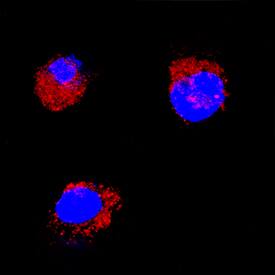Feline SCF/c-kit Ligand Antibody
R&D Systems, part of Bio-Techne | Catalog # AF2268


Key Product Details
Species Reactivity
Applications
Label
Antibody Source
Product Specifications
Immunogen
Lys26-Ala190
Accession # P79169
Specificity
Clonality
Host
Isotype
Scientific Data Images for Feline SCF/c-kit Ligand Antibody
SCF/c‑kit Ligand in Feline PBMCs.
SCF/c-kit Ligand was detected in immersion fixed feline peripheral blood mononuclear cells (PBMCs) using Goat Anti-Feline SCF/c-kit Ligand Antigen Affinity-purified Polyclonal Antibody (Catalog # AF2268) at 15 µg/mL for 3 hours at room temperature. Cells were stained using the NorthernLights™ 557-conjugated Anti-Goat IgG Secondary Antibody (red; Catalog # NL001) and counterstained with DAPI (blue). Specific staining was localized to cytoplasm. View our protocol for Fluorescent ICC Staining of Non-adherent Cells.Applications for Feline SCF/c-kit Ligand Antibody
Immunocytochemistry
Sample: Immersion fixed feline peripheral blood mononuclear cells (PBMCs)
Western Blot
Sample: Recombinant Feline SCF/c-kit Ligand (Catalog # 2268-SC)
Formulation, Preparation, and Storage
Purification
Reconstitution
Formulation
Shipping
Stability & Storage
- 12 months from date of receipt, -20 to -70 °C as supplied.
- 1 month, 2 to 8 °C under sterile conditions after reconstitution.
- 6 months, -20 to -70 °C under sterile conditions after reconstitution.
Background: SCF/c-kit Ligand
Feline SCF (stem cell factor; also known as c-kit ligand) is a type I transmembrane (TM) glycoprotein that plays an important role in a number of fetal and adult developmental processes (1‑4). It is synthesized as a 274 amino acid (aa) precursor that contains a 25 aa signal sequence, a 190 aa extracellular region, a 23 aa TM segment and a 36 aa cytoplasmic tail (5). Within the extracellular region there are two intrachain disulfide bonds and four alpha-helices. Although the predicted molecular weight is 19 kDa, the native molecule is anywhere from 28‑40 kDa in size and reflects both N- and O-linked glycosylation (1). Glycosylation is not necessary for bioactivity (6). The transmembrane form of SCF can be cleaved proteolytically, generating a 165 aa soluble form. Circulating SCF exists as both a monomer and nondisulfide-linked homodimer, with monomer predominating (50% to 75%) (6). Both the soluble and TM forms have bioactivity. Their principal targets may be different, however (7). A second, alternate splice short form of feline SCF has been identified (5). It too, is membrane bound and contains 246 aa residues. It will not give rise to a soluble form, since alternate splicing removes the proteolytic cleavage site used in the long form. The ratio of long form to short form varies tissue to tissue (1). Soluble feline SCF shares 93%, 93%, 90%, 87%, and 78% aa sequence identity with porcine, canine, bovine, human and mouse SCF, respectively. Cells known to express SCF include endothelial cells, fibroblasts and keratinocytes (1).
References
- Broudy, V.C. (1997) Blood 90:1345.
- Nakagawa, S. and T. Kitoh (2000) Curr. Opin. Hematol. 7:133.
- Yoshida, H. et al. (2001) J. Invest. Dermatol. Symp. Proc. 6:1.
- Kang, J. and S.D. Der (2004) Curr. Opin. Immunol. 16:180.
- Dunham, S.P. and D.E. Onions (1996) DNA Seq. 6:233.
- Hsu, Y-R. et al. (1997) J. Biol. Chem. 272:6406.
- Kapur, R. et al. (1998) Blood 91:879.
Long Name
Alternate Names
Gene Symbol
UniProt
Additional SCF/c-kit Ligand Products
Product Documents for Feline SCF/c-kit Ligand Antibody
Product Specific Notices for Feline SCF/c-kit Ligand Antibody
For research use only